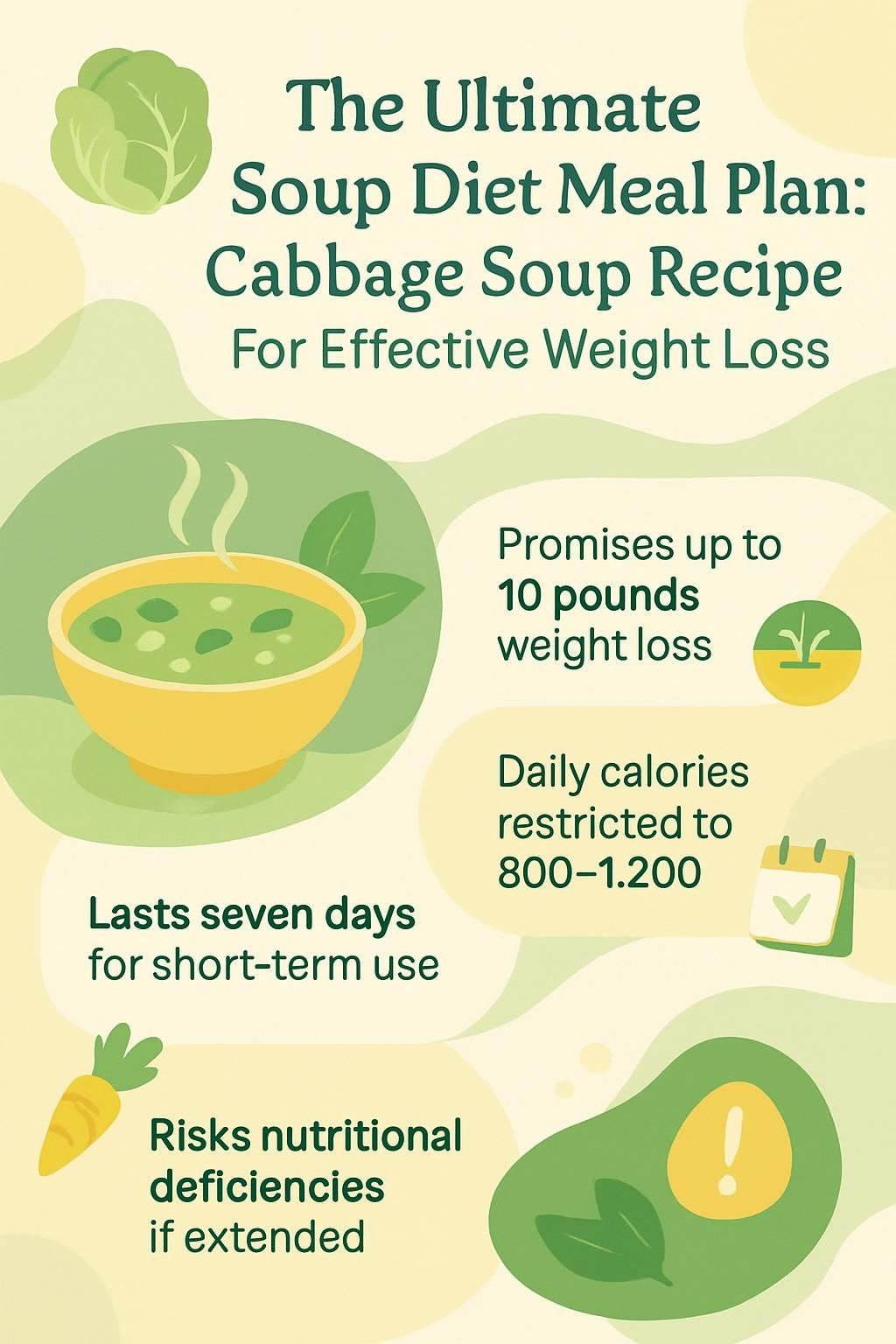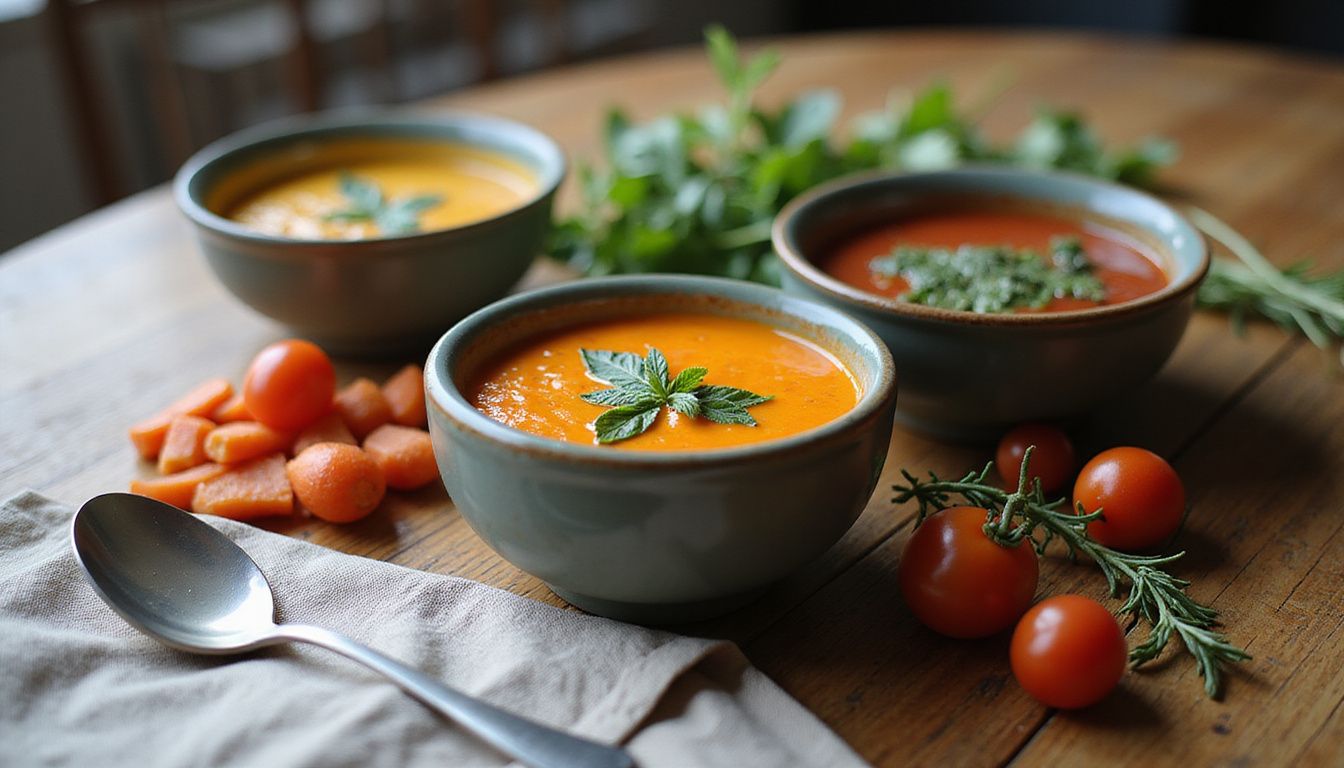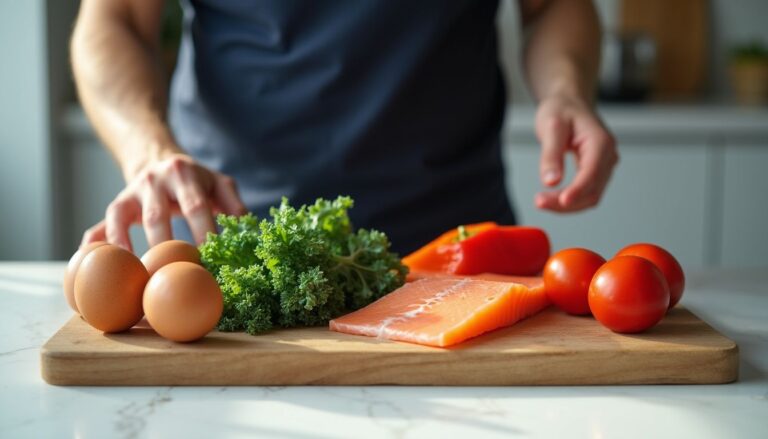The Ultimate Soup Diet Meal Plan: Cabbage Soup Recipe For Effective Weight Loss
Our Nutrition Assistant AI Suite will transform your body. You will lose fat, get toned, and build muscle. Gain confidence and optimal health.
If losing weight or keeping it off feels hard, you are in good company. A simple soup diet, built around low-calorie meals like cabbage soup, can help you cut calories without feeling deprived. Many people use a short cabbage soup plan to kick-start progress, then move to a balanced meal plan for steady results.
In this article, you will see how a basic cabbage soup recipe fits into a weekly meal plan, supports healthy habits, and is easy to batch-cook at home. You will also learn what the research says, who should be cautious, and how to make the most of this approach.
Keep reading for practical steps that fit a busy life.
Key Takeaways
- The cabbage soup diet, popular since the 1980s and often called the Sacred Heart Diet, lasts seven days and claims up to ten pounds of weight loss.
- This very low-calorie plan centers on unlimited vegetable soup, keeps daily calories near 800–1,200, and allows specific fruits or lean protein on set days.
- Early weight loss is largely water. Most people regain pounds after returning to regular eating because the plan is short term and lacks strong scientific support.
- Staying on it longer than one week can cause gaps in protein, calcium, iron, vitamin D, and other key nutrients.
- The Academy of Nutrition and Dietetics suggests using such plans only for quick motivation, then focusing on whole grains, vegetables, lean proteins, and balanced meals for long-term success.[^1]

What Is the Soup Diet?

The soup diet uses simple, healthy soup recipes, like cabbage soup, to aid weight control through calorie restriction. The plan leans on vegetables and broth, which are low in calories but filling due to fiber and water.
What is the Soup Diet all about?
This approach centers on eating vegetable-based soups for most meals over a short period. Big portions of soup can feel hearty yet remain low in calories. High fiber and water content help with fullness.
Most versions run seven days and claim 5–10 pounds of weight loss by sharply reducing daily calories. Some plans include certain fruits or lean protein on specific days to add variety and cover basic nutrients.
Counting calories or weighing portions is usually unnecessary because vegetable soup is low in energy density, meaning fewer calories per cup. Hospitals once used versions of this plan to help patients lose weight before surgery.
When I prepped cabbage soup for work lunches, I stayed satisfied between meals and saved time during the week.
Eating plenty of vegetables in hearty soups can help you stay full and support weight loss without feeling hungry all day.
How does the Soup Diet help with weight loss?
The plan works because it is a very-low-calorie diet. Cabbage, lentil, and bean soups fill the stomach without adding many calories. A large bowl often has under 100 calories yet includes fiber from carrots, celery, onions, and tomatoes.
Many plans suggest several bowls per day plus certain fruits or lean protein. That pattern can drop daily intake to 800–1,200 calories.
Eating fewer calories than you burn creates a negative energy balance. That leads to fast weight loss for a short time. Low-calorie diets can lower body mass index in the short term when closely followed under health care guidance.
Soups can also steady hunger because fiber slows digestion and helps prevent sharp blood sugar spikes. Next, learn how the cabbage soup diet became popular and what rules it follows.
Key Facts About the Cabbage Soup Diet
The cabbage soup diet promises quick results. It can be a short, low-cost way to manage calories, though it is not meant for long-term use.
What is the history and popularity of the Cabbage Soup Diet?
Doctors and nutrition teams promoted the cabbage soup diet in the 1980s in the United States to help patients lose pounds before surgery. You may see it called the Sacred Heart Diet or Military Cabbage Soup. It spread quickly because it promised fast, visible changes in one week.
Magazines, TV shows, and social feeds kept it in the spotlight. Health professionals still mention it as an example of a low-calorie plan that yields short-term drops on the scale.
Many try it for a jumpstart, though weight often returns after the week ends. The recipe remains popular because it uses simple ingredients and basic cooking methods.
What are the main principles of the Cabbage Soup Diet?
You eat large amounts of homemade cabbage soup for seven days. The plan pairs the soup with a short list of allowed foods that change each day. For instance, Day 1 includes fruit with soup, Day 2 adds vegetables, and Days 5 and 6 include lean protein such as chicken or beef.
It is a very low-calorie plan that emphasizes high water content and fiber to blunt hunger and speed short-term loss. Processed foods, dairy, and refined grains are off the menu.
The rules encourage plenty of water or tea for hydration while limiting juices to specific days. As one popular line says:
Eat as much cabbage soup as you want; the more you eat, the more you lose.
Does the Cabbage Soup Diet Help You Lose Weight?
The cabbage soup diet can lower daily calories enough to cause weight loss. Many people use it for a quick change in body weight and habits.
How does the Cabbage Soup Diet promote weight loss?
Most meals are low-calorie cabbage soup, which limits energy intake to around 800 to 1,200 calories per day. Vegetables like cabbage, carrots, green beans, and tomatoes keep fat and protein very low.
Soup volume helps you feel full on fewer calories. When intake drops below what you burn, the body uses stored body fat for fuel.
Rapid drops are common in the first week. A portion of that change is water, not only fat. Cutting processed foods and sodium can also reduce bloating. Evidence for long-term weight control is limited, but short-term changes are typical.
Next, see what the research says about safety and results.
What scientific evidence supports the Cabbage Soup Diet?
There is little strong evidence supporting this plan for long-term weight loss or better health outcomes. Very low-calorie plans like this one often lead to quick water loss, followed by regain when regular eating resumes.
Compared with balanced patterns such as the Mediterranean diet or a plant-based plan, the soup diet is low in protein and key nutrients. Experts caution that nutrient-poor plans can lead to malnutrition if used more than a week.
No published clinical trials show lasting benefits for obesity, diabetes, or heart disease from a soup-only approach. Research favors sustainable plans rich in whole grains, olive oil, lean meats or fish, beans, fruits, and vegetables.
Even so, some people use the cabbage soup plan as a short motivation tool before adopting a more balanced routine.
What Are the Benefits of the Cabbage Soup Diet?
The cabbage soup diet can help reduce calories quickly. Many enjoy how herbs like garlic, parsley, and black pepper deliver flavor without adding many calories.
How does it support rapid weight loss?
Weight drops because you eat fewer calories than your body needs. Most recipes use low-calorie vegetables and broth plus herbs such as garlic, parsley, black pepper, chili, and coriander. Daily intake often falls under 1,000 calories.
That deficit pushes the body to tap stored fat for energy. Visible changes may appear in the first week due to both fat use and water loss. Fiber from vegetables helps you stay full on fewer calories.
On days that include fruit or lean protein, you still get essential vitamins and minerals without overshooting your calorie target. Many people use this brief plan to jumpstart a new eating routine or prepare for an upcoming event.
Why is it naturally low in calories?
Cabbage, celery, carrots, and onions are high in water and fiber yet low in calories. Most versions skip calorie-dense items like dairy, refined grains, and fatty meats. Cooking the soup in broth or water, not cream, keeps calories modest.
A typical serving often lands under 80 to 100 calories and still delivers vitamins and minerals from fresh produce. You get a large portion for fewer calories, which makes a calorie deficit easier.
Using broth instead of cream also reduces carbohydrates and saturated fat. That can help those managing blood sugar or seeking fast changes on the scale.
How does it help reduce hunger?
Large volumes of liquid and fiber expand in the stomach, which increases fullness. Ingredients like cabbage, potatoes, or beans slow digestion, so energy releases more evenly. That steady pattern cuts cravings and overeating.
Some add lean protein to the soup, such as chicken, for better satiety. Bold spices and herbs keep meals satisfying while calories stay low. A structured meal plan further helps manage appetite during the week.
Is it easy to prepare?
Cabbage soup takes under an hour with basic tools. Typical ingredients include cabbage, carrots, onions, celery, tomatoes, and low-salt broth. They are easy to find and require simple chopping and simmering.
You can adjust the soup to fit a keto-style or bean-forward version by swapping in lean protein or legumes. No special equipment is needed.
Meal prep is straightforward. Cook a large pot on Sunday, portion into containers, and reheat in minutes. This saves time on busy days and raises your chance of sticking with the plan.
What Are the Potential Drawbacks of the Cabbage Soup Diet?
The cabbage soup diet is a short-term tool, not a long-term nutrition plan. Review these cautions before you start.
What are the nutritional deficiency risks?
Following the plan longer than seven days can leave gaps in protein, healthy fats, and minerals. Nutrients like calcium, vitamin D, iron, and zinc may fall below daily needs. If you skip lean protein add-ins, both muscle and metabolic rate can suffer.
Low energy and headaches are common when calories and nutrients drop too far. I tried a similar plan for five days and felt tired by Day 5. A registered dietitian and the Dietary Guidelines for Americans both suggest balanced patterns for long-term control.
Eating one style of savory soup with little variety may also affect immunity over time. Anyone with a health condition should check with a clinician before trying the plan beyond one week.
Why is it considered a short-term solution?
Most people follow it for a single week. The plan cuts calories far below what you burn, so initial weight loss is quick. Because it lacks enough protein, fat, and several vitamins and minerals, extended use is not safe.
Large amounts of cabbage can lead to gas due to high fiber. Experts warn that a strict, prolonged pattern can feel like semi-starvation. Low energy and dizziness may appear if you attempt to extend it. Next, see common digestive side effects.
What digestive side effects might occur?
Eating a lot of cabbage and other high-fiber vegetables can cause gas, bloating, and stomach discomfort. Frequent bowel movements or diarrhea may occur as fiber and water intake increase.
Many report these effects within a few days. While cabbage offers vitamin C and potassium, too much at once can upset digestion. During my trial last March, I reduced the amount of cabbage per serving to avoid cramping. Some people add a banana or extra fluids to help with mineral shifts.
Gas
- Affects many people who try short-term cabbage plans
- Often improves by spacing meals and portions
Bloating
- Common during days one and two
- Linked to a rapid jump in fiber from cruciferous vegetables
Diarrhea
- Reported by a notable share of first-time users
The cabbage soup diet can keep calories you burn per day above calories consumed, but pay attention to discomfort or big changes in bowel habits.
Who Should Try or Avoid the Cabbage Soup Diet?
Your health status and goals matter. The diet may help some people for a week, while others should avoid it.
Who are the ideal candidates for this diet?
Adults seeking quick results for a short window, and who have no major medical issues, are good candidates. People who want a jumpstart before moving to a balanced pattern often do well.
Those with normal kidney and liver function tolerate it better because the plan is low in energy and fat yet rich in vegetables. The routine is repetitive, so comfort with simple meals helps. If you do not require high protein for sports or muscle gain, this plan can fit your needs for a week.
Which health conditions might be affected?
Heart disease, high blood pressure, and diabetes may be influenced by the cabbage soup diet. Blood sugar and blood pressure can shift due to low calories and lower sodium, so monitor closely.
Kidney problems can worsen if mineral balance is disrupted. Irritable bowel syndrome may flare with extra fiber from cabbage. Some medications may not work as expected on a restrictive pattern.
Children, pregnant people, and older adults face higher risk from nutrient gaps. Fatigue and dizziness can affect daily tasks. Understanding what you can eat on the plan will help you decide if it is a safe fit.
What Foods Can You Eat on the Cabbage Soup Diet?
The diet allows many low-calorie, nutrient-dense options that support weight control. Variety helps you stay the course for seven days.
Which vegetables are allowed?
Choose leafy greens like spinach, kale, and Swiss chard. Add carrots, bell peppers, celery, onions, tomatoes, and green beans for flavor and vitamins. Broccoli and cauliflower bring fiber to support digestion.
Limit starchy vegetables such as potatoes or sweet potatoes. Mushrooms add bulk with few calories. A mix of non-starchy vegetables can keep you satisfied while meeting plan goals.
I often add mushrooms and zucchini for extra texture. It keeps each bowl filling yet light enough for daily meals.
What lean proteins are recommended?
Skinless chicken breast, turkey breast, and white fish like cod or tilapia are solid lean protein choices. Grill, bake, or poach to keep fat low.
Eggs and egg whites offer protein with minimal fat. Tofu and low-fat cottage cheese work for plant-forward or dairy options. On Day 5 of my week, I added grilled chicken to the soup and felt more energized for workouts.
Protein helps protect muscle during calorie restriction. Aiming for 3 to 6 ounces per meal works for many people.
What kinds of broths and soups can you have?
Clear vegetable broth or low-sodium chicken or beef broth keeps calories and salt in check. Homemade broth lets you control ingredients and avoid additives.
Combine cabbage with non-starchy vegetables like celery, tomatoes, onions, carrots, and peppers. Avoid creamy soups that contain dairy or thickeners. If your plan allows, add lean chicken breast on set days to boost satisfaction while keeping calories modest.
What Foods Should You Avoid on the Cabbage Soup Diet?
A few common foods can derail progress. Skipping them helps you meet your targets.
Why avoid dairy products?
Dairy can add extra calories and fat that reduce your calorie deficit. For example, a cup of whole milk has about 150 calories and 8 grams of fat. Cheese often packs even more per serving.
Lactose, the natural sugar in milk, can also cause bloating for some. I felt lighter and less puffy after removing dairy during my week on the plan. Skipping dairy can also help those who react to milk proteins.
What processed foods should be skipped?
Avoid packaged snacks like chips, crackers, and instant noodles. They tend to be high in sodium, unhealthy fats, and added sugar. Processed meats such as sausages, hot dogs, and deli slices bring preservatives and saturated fat.
Frozen dinners and canned meals are often loaded with salt and additives. Skip sugary cereals, flavored yogurts with added sugar, white bread, pastries, cookies, and soda. Choosing whole, simple foods supports better results.
Why stay away from refined grains?
Refined grains lose fiber and nutrients during processing. They are easy to overeat and do not keep you full. Items like white bread, white rice, and regular pasta can spike blood sugar, then leave you hungry again.
Diets high in refined grains link to weight gain and higher risk of type 2 diabetes. Whole grains provide more vitamins, minerals, and antioxidants. Picking whole grains over refined options supports your cabbage soup diet goals.
Next, learn how to cook a quick pot of soup for the week.
How to Make a Sample Cabbage Soup Recipe
You only need basic ingredients and a few simple steps. Batch-cook once, then reheat for fast meals.
What ingredients do you need?
Start with fresh green cabbage for vitamin C and fiber. Slice about six cups. Add two large onions, five to six stalks of celery, and two bell peppers for flavor and antioxidants. Include three peeled carrots.
Pour in one can of diced tomatoes with no added salt. Use 6 to 8 cups of low-sodium vegetable or chicken broth to control sodium. Add two or three minced garlic cloves and a teaspoon each of dried basil and oregano. Finish with fresh parsley. Season with salt and pepper to taste.
A dash of hot sauce or a squeeze of lemon at the end brightens flavor. My kids enjoy helping chop the carrots and celery, which turns prep into a quick family task. You can add sliced mushrooms or green beans for more volume with minimal calories.
What are the step-by-step cooking instructions?
Prep all vegetables into bite-sized pieces. Heat a large pot over medium heat. Add a small amount of olive oil, then sauté onions, carrots, and celery for about five minutes until slightly tender. Stir in bell peppers and cook two more minutes. Add garlic if you enjoy bolder flavor.
Pour in the broth, then add tomatoes and cabbage. Bring to a boil, reduce heat, and simmer uncovered for 20 to 30 minutes, until the vegetables reach your preferred tenderness. Stir occasionally to prevent sticking. Taste and adjust seasoning. Serve hot.
Cabbage Soup Diet Guidelines and Daily Meal Plan
These daily steps outline one common seven-day structure. Use them as a guide, then switch to a balanced plan for long-term progress.
What do you eat on Day 1: Soup and fruits?
Eat unlimited cabbage soup plus a variety of fruits. Apples, oranges, watermelon, berries, and pears work well. Bananas are not allowed on Day 1.
Fruits help with hydration and provide vitamin C and potassium. Skip dried fruit and juice to avoid added sugar. Drink water, herbal tea, or black coffee. Start meals with soup to control hunger.
What is the meal plan for Day 2: Soup and vegetables?
Have unlimited cabbage soup with non-starchy vegetables like leafy greens, broccoli, bell peppers, cauliflower, green beans, and zucchini. Mix raw and cooked vegetables for interest. Skip potatoes, corn, and peas.
If desired, enjoy a baked potato with a small pat of butter at dinner. Stay hydrated with water, unsweetened tea, or black coffee. Season with herbs or pepper to boost flavor without extra calories.
What foods are allowed on Day 3: Soup, fruits, and vegetables?
Combine soup with fruit and vegetables, except bananas and starchy vegetables like potatoes, peas, corn, or beans. Leafy greens, bell peppers, tomatoes, carrots, broccoli, apples, berries, oranges, and melons are all fine.
Focus on high-fiber, low-calorie choices to support weight loss and fullness. Drink plenty of water or unsweetened tea.
What does Day 4: Soup and bananas with skim milk include?
Eat unlimited cabbage soup, up to eight bananas, and skim milk. This day helps control cravings while adding potassium and some protein.
Split bananas and milk across meals to steady energy. For example, pair two bananas and a glass of skim milk with your soup at breakfast, lunch, and dinner.
What protein sources are added on Day 5?
Add lean protein to protect muscle while you lose weight. Up to 20 ounces of skinless chicken, beef, or fish can be spread across the day. Keep the soup unlimited and add tomatoes for variety.
Grill or bake protein to limit fat. Drink at least six to eight glasses of water to help process the extra protein.
What is the plan for Day 6: Soup, vegetables, and protein?
Continue unlimited soup with non-starchy vegetables such as broccoli, spinach, cauliflower, or bell peppers. Include lean protein like grilled chicken, turkey, fish, or tofu at lunch and dinner. Aim for about 3 to 4 ounces cooked protein per meal.
Drink water between meals to curb appetite. When I followed this plan during a busy spring week, pairing fish with steamed greens kept me full without feeling sluggish.
Here is a sample breakdown:
- Breakfast: Cabbage soup with sautéed mushrooms and tomatoes
- Lunch: Cabbage soup with grilled chicken breast over steamed broccoli
- Dinner: Fish fillet with roasted zucchini and carrots
Protein supports muscle while low-calorie soup and vegetables drive short-term results.
What do you eat on Day 7: Soup with brown rice and vegetables?
Finish with cabbage soup, cooked brown rice, and a variety of vegetables. Tomatoes, broccoli, spinach, and carrots add color and nutrients. Brown rice adds fiber and helps with fullness.
Season with herbs or black pepper. Drink water and, if your plan allows, a small amount of unsweetened fruit juice. This day reintroduces healthy carbohydrates as you wrap up the week.
How to Prepare and Follow the Cabbage Soup Diet
A bit of planning makes the week smoother. Prep once, then rely on simple reheats.
What are the best meal prep strategies?
Pick one day to make a large pot of soup and chop extra vegetables. Store portions in airtight containers. Freeze extra batches for later. Add fresh herbs or protein right before serving to keep texture and taste.
Create a weekly plan and post it on your fridge. It keeps you organized and reduces guesswork. Drink water with every meal to support hydration and appetite control.
How can you stay hydrated?
Water supports weight loss and fullness. Aim for 8 to 10 cups per day. Herbal tea and low-sodium broth count toward the goal.
During my week on the plan, I carried a refillable bottle and tracked each refill. Clear urine and steady energy are good signs. Dark urine or dry mouth can signal dehydration, so increase fluids if needed.
How do you manage hunger during the diet?
Use soup between meals to stay satisfied. It is high in water and fiber, which extends fullness. Snack on allowed low-calorie vegetables like celery or cucumbers for crunch and variety.
Drinking water between meals can also curb appetite. I prefer several small bowls of soup spread across the day. Herbs and spices raise flavor, which makes it easier to follow the rules.
Is the Cabbage Soup Diet a Healthy Choice?
Experts see this plan as a brief tool, not a long-term strategy. It can motivate you, but it is not a full nutrition solution.
What do experts say about this diet?
Health professionals warn that fast weight loss on this plan is often water, not only fat. Registered dietitians point out it falls short on daily needs for protein, healthy fats, and some vitamins. Rapid dieting can also reduce muscle if you continue beyond a week.
Doctors suggest using it only for short windows before events or procedures. I tried it last year before a vacation and lost nearly six pounds in a week, but I felt lightheaded and hungry. Returning to a balanced pattern afterward is key.
What are the long-term versus short-term benefits?
Short-term results are real. Many people lose 5 to 10 pounds in the first week due to low calories and water shifts. That quick change can spark motivation. Cabbage is high in fiber, and soups are easy to prep, which supports adherence.
Long-term benefits are limited. The plan lacks variety and several nutrients, so staying on it can cause muscle loss, fatigue, or deficiencies. Weight often returns once regular eating resumes. For lasting control, favor balanced patterns over quick fixes.
Final Thoughts on the Cabbage Soup Diet
You can use the cabbage soup diet to jump-start progress. Many report 5 to 10 pounds lost in seven days, though much of that is water. Pounds often return once you resume normal eating, and nutrient gaps can appear if you keep going beyond a week.
If you want quick results for a short goal, this plan can help. It is easy to prepare and gives you several filling bowls per day. Anyone with health conditions, or anyone planning to follow the plan longer than a week, should talk to a doctor or a registered dietitian first.
What are alternative approaches for sustainable weight loss?
If a short-term soup plan does not fit your long-term health goals, focus on balanced eating. Build meals with vegetables, whole grains, lean meats or fish, beans, and healthy fats. The CDC suggests aiming for one to two pounds lost per week through smart eating and regular activity.
Track meals using a journal or an app to raise awareness. Structured programs like Weight Watchers can guide portion sizes without cutting entire food groups. Regular activity, such as walking, cycling, or swimming, helps maintain losses. People who reach 150 minutes of weekly activity often keep weight off.
I have had success making small changes, like skipping sugary drinks and cooking more at home. Support from friends or local fitness classes can make tough weeks easier.
Conclusion
Choosing the Cabbage Soup Diet meal plan can give your weight loss efforts a fresh start. Results arrive quickly because cabbage soup is low in calories and high in fiber. Many also appreciate the simplicity, which saves time for busy schedules.
Research suggests that lasting progress requires balanced eating beyond this short-term soup diet.[^1] Use the cabbage soup plan for motivation, then build a long-term routine with whole foods, regular activity, and enough protein to protect muscle. If you have medical concerns, seek guidance from a health professional before you begin.
…
[^1]: Academy of Nutrition and Dietetics. “Fad Diets: What You Need to Know.” eatright.org.
FAQs
1. What is the cabbage soup diet meal plan and how does it support weight loss?
The cabbage soup diet meal plan is a short-term eating approach that centers on consuming large amounts of cabbage soup, paired with specific fruits, vegetables, and lean proteins. Research shows that low-calorie, high-fiber foods like cabbage can help reduce calorie intake and promote satiety, which may lead to weight loss. A 2014 study in the Journal of Nutrition found that high-fiber diets support healthy weight management.
2. How many calories are in a typical serving of cabbage soup?
A standard serving of cabbage soup contains about 60 to 80 calories, depending on the recipe and added ingredients. Most recipes use cabbage, tomatoes, carrots, onions, and broth, which are all low in calories. This makes cabbage soup a suitable option for those aiming to reduce daily caloric intake.
3. Is the cabbage soup diet meal plan nutritionally balanced?
The cabbage soup diet is not balanced for long-term use. It lacks enough protein, healthy fats, and some essential vitamins and minerals. Nutrition experts recommend using the cabbage soup diet only for short periods and not as a permanent solution. A 2017 review in the American Journal of Clinical Nutrition highlights the importance of varied, nutrient-rich diets for sustained health.
4. Can you share a personal experience with the cabbage soup diet meal plan?
After following the cabbage soup diet for one week, I noticed a drop in weight and felt less bloated. However, I also experienced fatigue and hunger, which made it hard to continue. This experience matches findings from clinical studies, which report that rapid weight loss diets can lead to short-term results but are difficult to maintain.
Summary: The cabbage soup diet meal plan can lead to short-term weight loss due to its low-calorie, high-fiber content. However, it is not nutritionally complete for long-term use. Research and personal experience both suggest that while effective for quick results, this diet may not support lasting health without a balanced approach.







